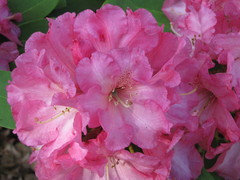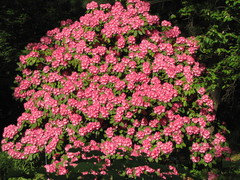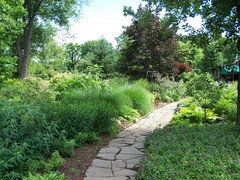Keeping Lamium Under Control
I want to plant lamium in a narrow (28'x3') bed along the side of my house which will include hydrangea, azalea, astilbe, hosta and some fern. How do I keep the lamium from invading into my lawn and will it choke out any of the other things that I'd like to plant? What about caladium bulbs, will they come up? I couldn't get a response to this posting in the groundcover forum.
Please help. Thanks.
Comments (48)
tjsangel
17 years agoHi,
My Lamium is not terribly invasive. It has formed a nice clump and blooms continuously. This is over 3 yrs. It's not a thick thick cover, your bulbs will be able to come through it. Now Sweet Woodruff is another story! Better have a whole yard for it, though it is beautiful. I recommend Lamium, I love it.
Jen
joy4me
17 years agoThere are different varieties (approx. 50) of Lamium, not quite sure. But, SOME of them are VERY invasive and will choke everything in its way in some areas. I have the yellow flowered vining type that's horrible..very pretty, but just so hard to get rid of. just need to miss a tiny piece of root and it's off and running again. Lamium is a deadnettle, I think, and in the mint family. There are supposed to be a few that stay contained, though I don't know just which they are. It also depends on where you live and your conditions too I suppose. You can check out invasive plants on the net and see if you can find the one you have.
Hope this helps.
Related Professionals
Otsego Landscape Architects & Landscape Designers · Saint Louis Park Landscape Architects & Landscape Designers · Severn Landscape Architects & Landscape Designers · Arlington Landscape Contractors · Belmont Landscape Contractors · Dixon Landscape Contractors · Hollywood Landscape Contractors · Seminole Landscape Contractors · Spring Landscape Contractors · Wilsonville Landscape Contractors · North Hills Landscape Contractors · Chatsworth Swimming Pool Builders · Clinton Swimming Pool Builders · South Miami Heights Swimming Pool Builders · West Puente Valley Swimming Pool Buildersinsideout
17 years agoI also have lamium and haven't found it to be invasive. I don't have the plant card handy, but it the white flowering type and it does make a bit of a mound. My mother in law also grows lamium, only hers is the pink flowering variety. Hers insn't invasive either. I would recommend lamium.
geoforce
17 years agoI just put in a gorgeous one this spring called "Beacon Silver". Very nice silver leaves with medium green edges, and a medium lavender flower. I HOPE it spreads!
George
janetr
17 years agoWhile this thread is still alive, I'd really like to know what other varieties people have found to be well-behaved.
George, I've done both in the past, and for that matter, in the present. Ground layering is just so nice and simple and with a higher success rate... ;o)
pegzhere
17 years agoI have heard 'Hermann's Pride' is well behaved and the leaves and yellow blooms are quite pretty. I bought some yesterday to plant but it started to storm and I haven't gotten to put it in yet. I also bought 'chequers' (was a good deal LOL) but I want to research that particular varuety before I plant so I know what to expect.
alisonn
15 years agoIn very deep shade and poor soil, I don't find that either the Beacon Silver or the old fashioned kind (the kind that a co-worker gave me because it was taking over HER yard) spreads very fast in a dry, very, very shaded area. With a little more light and water, I bet the old-fashioned kind would have taken over my yard in the last 6 years since I planted it. It has spread, but not a whole lot.
sunrisedigger
11 years agoUnder my Norway Maple- and honestly a known challenge to many Dead Nettle was really one of my last options. Dry shade's not too much fun. Lily of the Valley grows with it and it's good not great Actually the circular bed right now looks nice with the purple Lamium in bloom. Can anyone suggest a third companion plant maybe taller? Could late single yellow tulips work? It's dappled shade. Is there a specie for that ? Thanks
dianne0712
11 years agoI have red nancy, which is really purple, and silver beacon, which has pink flowers and they are very well behaved. On the other hand the yellow one which crept out from our neighbours is a garden thug!
anniegolden
11 years agoJust a note regarding hydrangea in a 3-foot wide bed. Only dwarf hydrangea will fit into this space. Here are some dwarf varieties:
H. Little Lime, 3' - 5' tall and wide
H. Pee Wee, 2' - 4' tall and wide
H. Pia, 2 1/2' tall and wideOf these, Pia is the only one I grow, and it is outstanding.
Christine
gamb
11 years agoI don't know for certain which varieties I have as they were planted 6 years ago, if memory serves, but my garden has two kinds of purple-flowered lamium, one with silver and green leaves and one with almost completely silver leaves. Both have been voracious growers (one of the few plants we've tried that does well in the shaded, very wet and heavy clay-filled corner of our yard), but they're not exactly invasive. They definitely spread, but they don't seem to be choking other plants out. Granted, I do cut them back extensively in the spring and fall.
kimka
11 years agoThe most invasive of the lamiums is Yellow archangel, Lamium galeobdolon. It has lovely yellow flowers in the spring. Hermann's pride is the better behaved version of it. But it can be hard to be sure you get Hermann's pride and not the very invasive species version. In dense shade, even archangel stays better behaved, but give it any sun at all and in a few years it is off and running and goes everywhere. But where you have a shady area that you don't want to tend at all like a steep slope, it will become a solid ground cover.
Angie
11 years agoThe Archangel quickly spread in my dry shade garden, it was suffocating trillium, bleeding heart and may apples. I spent hours pulling it out and it's already starting to sprout back up. Stay far away from this variety unless you need something completely covered!
rj56
11 years agoI have had White Nancy and Beacon Silver for many years. They grow freely in the bed but do not venture into my lawn. The mounds will sometimes die out in the center, but they are easily refreshed. In dry shade, for me, they are easily controlled.
docmom_gw
11 years agoI moved into a new house last fall. This spring we discovered that we do, in fact, have extensive beds full of the Archangel variety of lamium. Unfortunately, I'm not a fan of yellow flowers in the shade. However, this horrible heat seems to be hard on the lamium. It's wilting beautifully. I'm hoping some of it won't make it to fall. But, once the rains begin and the ground is moist, my shovel will be busy!
Martha
stukin
9 years agoAbout 40 years ago, I had a plant shop. At the end of the busy season, I had a left over hanging basket of lamium that was pretty ratty-looking. I dumped the soil ball out of the pot and threw it into the woods in front of my house. I guess it liked where it landed, because the following spring I noticed that it had come back to life. I assumed that it was dead from the cold weather not knowing that it's native to Alaska and extremely hardy. I left it there just to see what it would do. It now covers an area of nearly a quarter of an acre, all wooded and all very shady. The thing that really intrigues me is that the lush crop of poison ivy that had controlled the area is now totally gone. I suspect that lamium might give off a substance, possibly through the roots, that kills competing plants. It doesn't seem to have any harmful effects on shrubs and trees, but it is devastating to other crawling, ivy-like plants (poison ivy, Virginia creeper, honeysuckle, English ivy, etc.) that it encounters. It may be invasive, but I love it. Any enemy of poison ivy is a friend of mine. I'm trying to get it to invade my neighbor's property that is covered with a disgusting, over-grown jungle of chrysanthemum-weed that gets over 8 feet tall. I find that the bright yellow flowers in spring don't last long enough for me to really enjoy them. Nothing except weed killer will eliminate lamium, as far as I can tell. I've tried growing it in the sun with limited success. If I give it enough water, it does reasonably well. In the shade, it's nearly indestructible. I love it!
shadeyplace
9 years agoMy husband calls lamiastrum "ground cancer". We have been trying to get rid of it for many years. It is fine in an area where nothing NOTHING else grows.
princessgrace79
9 years agoI have a variagated type with pink flowers, and it has spread but not aggressively.
BetsyKristl
9 years agoI have had so many lamiums in my gardens that I don't know one from the other anymore. Yellow archangel is nothing short of hell once it's established. It smothered hosts, geraniums, heucheras,... Of course I planted it because it filled in fast and kept out the weeds - what a dope that I thought it would stop growing once it had covered all the open space! It took me years to get rid of that, and since then at least one of my pink lamiums has gone invasive. It's not as bad as the Yellow Archangel, but it's bad enough.
I'm happy to hear from Stukin that it can kill off other vines. I have english ivy growing through my rose garden, smothering the rose bushes at ground level. I'd love to be rid of that - it doesn't come up easily by pulling and I can't spray so close to a rose. Thanks for that tip!
LaVidaMd
9 years agoI'm so glad this post is still going.
We have lamium that the previous homeowner planted under some azaleas. It is there and it appears to be healthy, but it hasn't spread. The soil in that area is very compacted, so I doubt it will ever spread. It's also near day lilies and it hasn't grown in to them at all.
jessaka
6 years agoOh, my. I have a variegated lamium, and I just love it, but this year it has grown so much that I am worried about my other plants. will it kill my May Apples, my vines. I didn't expect it to be growing into other things. It has already taken over the creeping jenny, which I do not care about, but my forest is full of ferns, hostas, and other shade plants. It seems like I have some hostas still growing it in. I have no idea what kind it is, but it looks like, Variegated Yellow Archangel, the worse kind, and it has finally reached my mayapples this year.
stukin
6 years agoSince my last comment on lamium in 2014, it has continued to thrive. As long as it gets enough water, it will even do well in full sun. Even my neighbor's mugwort is no match for my lamium, but lamium is no match for my bamboo. I've transplanted ferns and any other plants I want to save. I don't have any hostas growing in the way of the advancing lamium, so I don't know which one would win in direct head-to-head competition. As my lawn gets smaller and my lamium spreads, I'm more convinced than ever that lamium gives off some sort of chemical that inhibits other plants. The area where the lamium is well established is almost totally free of competing plants. What was a thriving patch of mostly poison ivy has been destroyed by the lamium. I have a sunny area where there are numerous Ilex opacas (American holly), and the hollies are doing fine.
jessaka
6 years agolast modified: 6 years agoThis is really scary stukin. my forest is full of shade plants, ferns, etc. that I don't want killed. the lamium has spread far and wide, and now is beginning to reach my other plants. I will be spending all summer trying to get rid of it. I can't move my ferns, etc. because that is the shade area. Can it be sprayed and killed that way? Yes, you can, and it seems like a good idea since it will kill other plants. I can only spray where nothing else grows. Such a beautiful plant to have to get rid of.
jessaka
6 years agoThank you stukin, I went out today with my roundup, and I sprayed where nothing else grows. my vision is really dim now, and so I could hardly see what I was doing. then I dug up some. it isn't near my other ferns. then I thought to wait several days to see what the roundup killed, and next I was thinking, in the winter when the lamium is still green I can spray because plants will have gone dormant. at least I think they do. my yard is a nightmare like yours. the first years I was here I killed euonymus because it was creeping all over the woods. I allowed the viriginia creeper to grow, and now I am fighting it. Then in the flower garden out front I made the mistake of planning Mexican primrose and fight it every year as it spreads and spreads, and out there I also have the bindweed.
It is a shame that you can't kill the bamboo. I saw a house I liked that was covered in trumpet vine and bamboo. I got some trumpet vine and put it out by the street. it is slowly growing, but it is far from the house. I seem to like things that take over and am sorry. I have creeping jenny that tried to take over, and I love this plant pennywort, and have it growing on the shady side of the house. I think it needs shade, and so I am safe, I hope.
I gave some of my lamium to three garden club ladies, and one friend and now I am trying to warn them about it. I have had mine for 6 years or more, and finally it is going nuts, or I am.
stukin
6 years agoWhere I live, it's now illegal to plant bamboo where it will invade other properties.
Give lamium to your friends. With friends like you, they won't need enemies.
I used to love Clematis paniculata. I made the mistake of buying a plant not knowing that it seeds itself prolifically. It's beautiful when it's in bloom. It's sometimes called Virgins' Bower, so I used to make my daughter sit under it while it was in bloom. It didn't work. She now has 2 daughters, but I'm not going to give her any for her yard. It didn't work for her and probably won't work for her daughters either.
We just got a drenching rain. The lamium looks incredibly lush and vibrant.
One of the very best ground cover plants I've ever found is sarcococa (look it up.) Very drought tolerant and shade-loving, although it will take some direct sun. It's evergreen and spreads slowly making it easy to control. The plant flowers in winter (February/March) and is incredibly fragrant. The flowers are so small they're almost invisible, but the fragrance is unmistakable. It's one of those rare items that not many people have ever heard of. It transplants easily in early spring given enough water to get it started. No... you won't find it at Home Depot. Because of the fragrance, it's sometimes grown as a potted plant to be brought inside in the spring. You won't see the flowers, but you'll definitely smell them.
Be very careful of Roundup. It has a very high dermal toxicity. Wear rubber gloves and always wash carefully after using it. There are some other broad-spectrum herbicides that are actually better. Roundup won't kill wild grape - one of my biggest problem plants.
Virginia creeper is used as an ornamental plant in some parts of Europe. They don't consider it a weed. I've seen it grown beautifully on trellises for a very nice effect.
Do you know clethra? It's a native deciduous shrub, and it's often planted next to a walkway or at the entrance to a house for the fragrance. It's about to come into bloom, and I can't wait for the perfume-like smell. The fan in my greenhouse draws in the smell and make the whole place smell fantastic.
jessaka
6 years agosarcococa and clethra are pretty, but I have never seen them before.
I find it is somewhat easy to control Virginia creeper, as I just grab and pull, and it never takes over. I am trying to grow it and honeysuckle on our fence that is mostly in the shade. not going too well, but I had this chain link fence. that is also where I have the trumpet vine. it is a very long fence.
I try to be careful with roundup and try to not use it much. I never know how much gets into my lungs. I normally only use it now on poison ivy, but most poison ivy I have just pulled by hand.
we have that wild grape too. I pull it up and it grows right back in the same spot. not to mention the paper mulberry trees that pop up all over, and the box elder and elm.
If I have not accidently sprayed olne hosta, one fern, and one Soloman's seal, I will have to move them.
I have a feeling that my friends won't believe me about the lamium. I wonder how much they have given away? in a few years they will be sorry.
I planted sweetgrass around my hydrangeas and ferns a year ago. Now that is a smell that I love. I came home from an Indian reservation in Florida one year with a braid of it, and then I bought one plug of it and then planted it in the yard. Plants that smell are wonderful.
gardengal48 (PNW Z8/9)
6 years agoSpotted deadnettle - Lamium maculatum - is seldom considered invasive and the named forms/cultivars are extremely well behaved garden plants. Lamium galeobdelon (now separated from the genus and renamed Lamiastrum galeobdelon) or yellow archangel is extremely aggressive and is a listed invasive in many areas. Even the form 'Herman's Pride', which is not supposed to spread, does so wildly in my climate.
But I have never had an issue with Lamium maculatum - an excellent evergreen groundcover for shade.....even rather dry shade. I think most of the issues re: lamum and invasiveness relates to the weedy forms, like henbit (Lamium amplexicaule) or purple deadnettle (Lamium purpureum) rather than to L. maculatum.
jessaka
6 years agoI just read on someone's blog that they killed it with pine needles. just poured them over the dead nettle. what would that do to ferns and hostas?
gardengal48 (PNW Z8/9)
6 years agoNot sure why pine needles would have any adverse effect..........unless they buried the plant like a foot deep! Pine needles are a commonly used mulch and they have no attributes that would make them suitable for 'killing plants'. But if you pile on any mulch or other covering thick enough, it will deprive the buried plant of the ability to photosynthesize and could smother it.
Just an FYI, but most blogs are just the musings of some yahoo who may or may not be the slightest bit skilled horticulturally. I would never take anything I read from them at face value without doing a lot of other research. Just saying...............
stukin
6 years agoMy lamium is growing under pine trees. Ferns and hostas would probably come up through the pine-straw if it's applied after everything is dormant. Hostas have become a weed in my yard. They seed themselves, and I now have them everywhere. The deer will eat the hosta leaves, but they don't seem to touch the lamium. The deer actually bed down in the lamium.
jessaka
6 years agoSo much for searching for pine needles. I am surprised that our deer have not touched all any of our hostas. Years ago they did, and so I put them near the house, but now the little forest is full of them, and they leave them alone. They don't eat the roses that grow in the field either. To bad our groundhogs don't eat lamium.
stukin
6 years agoMy little 19lb. chorgi (chihuahua/corgi cross) got his first woodchuck today. He cornered it, and I beat it to death. The woodchuck was bigger than he is, but he's incredibly spunky for a little guy. I've got the bite scars on both hands to prove it. Woodchucks eat almost anything that humans eat. If we don't eat it, neither do they. Even if they ate lamium, you'd need a herd of them to do any significant damage. I doubt that even goats would eat lamium. In my case, I like the lamium. It has tamed an area that was nearly impenetrable with poison ivy, wild grape, Virginia creeper, bittersweet, honeysuckle, euonymus, wild raspberries, mugwort, etc. I went through the woods this spring and transplanted as many ferns as I could find. Now the lamium is free to take over the whole area... and it is.
jessaka
6 years agoHow will you stop the lamium from eventually reaching your ferns?
We feed our woodchucks. They don't bother any of our other plants, but whenever we planted watermelons and cantaloupe, they would get it first, so we gave up and just planted it for them.
there is lamium growing around one hosta and soloman's seal and has been for some time, also it is around an ornamental grass and has been there for years, but after reading about it, I want it gone. Still the ground looks better with it growing on it instead of having to now deal with weeds.stukin
6 years agoThe ferns are not where the lamium is. There might have been some ferns before the lamium took over, but they're long gone by now.
I have numerous large clumps of ornamental grasses growing among the lamium, and they seem to be compatible. That area is in full sun, so the lamium doesn't grow as vigorously as it does in the shade. There are also some large holly trees in that area. The lamium grows beautifully under the hollies where there's shade.
The lamium hasn't yet reached the area where there are still some ferns. I doubt that I'll be around to see that happen. I've moved a good number of the ferns that I wanted to save. I have a marshy/swampy area where the ferns are nearly as tall as I am. I have swamp marigold, skunk cabbage, and various other wet-loving plants, but the lamium is nowhere near them.
The swampy area is the graveyard for the woodchucks, squirrels, rabbits, chipmunks and other animals I kill whenever I get the opportunity. It seems as if the more I kill, the more of them there are. The overabundance of prey animals has brought poisonous snakes to the feast. I've seen the first copperheads in over 40 years, and it's due to the fact that there are so many rats, chipmunks, and other critters they feed on. The snakes are fine in the marsh. They don't bother me, and I don't bother them. The resident coyote is getting fat on woodchucks and rabbits. I now have a family of red foxes that are competing with the coyote. My little dog has an instinctive aversion to snakes, but he'll chase just about anything else, including deer.
The bottom line on the lamium is that it controls weeds very effectively... unless you call lamium a weed. It's not native to this area, so I guess it's technically an invasive plant - but not a weed. One thing I particularly like about it is the fact that it doesn't climb. It doesn't cause skin reactions like poison ivy. It's not susceptible to diseases like pachysandra. It can take the coldest weather we'll ever get. It survives drought even though it prefers wet conditions. Walking on it doesn't seem to hurt it. It hides rocks, stumps, downed tree limbs, and other unsightly things. Animals don't eat it. What's not to like? Just learn to love the lamium.
jessaka
6 years agoI feel like I rushed out of here with a short note. I just have to say that your description of killing the groundhog really bothered me, as did your swamp graveyard. Animals feel pain; they have a right to life. I don't care what your reason is for killing so many; it isn't right. I will not be back here to read anymore.
Pamela Guevara
6 years agoNice to hear some don't find spotted dead nettle invasive. But about 10 or 12 years back I bought, oh, three or four tiny pots of it to try in a shaded plated area I had out back and I have been fighting the White Nancy Horde ever since. No, it did not stay in the bed like a good little plant and has taken over the yard, the woods around the house and every spring pops up EVERYWHERE. I have tried pulling, spraying, dumping hot water on it. It is like Whack-A-Mole - you think it is gone and it pops up somewhere else. This is as bad, or worse, than creeping charlie and short of setting fire to my entire yard I can't think of a way of getting rid of it. Frankly, that last part I am considering next spring - getting a blow torch and scorching it where I find it.
stukin
6 years agoAbout 30 years ago, I pulled a ratty-looking lamium out of a hanging basket and threw it in the woods not realizing that it was hardy. The following spring, I found a beautiful patch growing happily and attacking the poison ivy and other vines in the area. It has spread ever since and has eliminated the poison ivy, honeysuckle, Virginia creeper, bittersweet, and all the other annoying climbing vines in the woods. It doesn't climb, so it is no danger to the trees and shrubs. Lamium has its place, but it's not for everyone. I like the yellow flowers and the fact that it won't succumb to drought, flood, cold or lack of sun. It has nearly eliminated the very persistent mugwort that I had been fighting for many years. For the most part, it looks a lot neater than what I had. The deer don't eat it, but they like to bed down in it. It holds the soil and prevents erosion. It's now attacking the mugwort in my neighbor's property, and that's a huge improvement. His yard looks like a garbage dump, but the lamium may someday make it look decent. It hides the garbage, somewhat. Hopefully, someday I'll see nothing but lamium next door. What's not to like?
laceyvail 6A, WV
6 years agoYour "Lamium" is likely the extremely aggressive Lamiastrum--the yellow flowers and the aggressive nature you describe are the giveaway.
stukin
6 years agoThanks for the info. About 30 years ago, this variety became very popular as a hanging basket plant. It was easy and fast and looked harmless. I had a plant shop around Christmas, and I had one basket left over at the end of the season. Without even thinking, I pulled the plant out of the basket and threw it into the woods. I didn't think it would survive the winter on top of the ground, so I was surprised the next summer to see it sending out new growth. I left it alone since it was in an area where it couldn't do any real harm. The area was overgrown with poison ivy and every other undesirable plant, so I didn't care. The lamium has destroyed nearly all the native undesirables and totally taken over with no work on my part. I can't find any trace of poison ivy that has not been smothered out. Even the mugwart is nearly all gone. I only wish the yellow flowers would last longer. If I had it to do over again, I'd plant sarcococa. IMO, that's the best ground cover plant in existence. It spreads very slowly for the first few years, but it gets extremely thick as the clumps grow together. The flowers are almost totally inconspicuous, but they are very fragrant in very early spring. The foliage is very dark green and very drought tolerant. Some winter-burn might occur from a dry, severely cold winter with insufficient snow cover, but it covers over as soon as the new growth comes out. It's very hard to find and usually very expensive... unless you know someone who will give you a few pieces. It grows just like pachysandra with underground runners. If I were more ambitious, I'd plant them side-by-side to see which plant wins a survival contest. I'd hope it was the sarcococa.
gardengal48 (PNW Z8/9)
6 years agoIt might depend on where one is located. In my area, Sarcococca - sweet box - is an extremely common and very popular plant and local nurseries sell a number of varieties. Most are not suitable as groundcovers as they do not form a dense mat but rather rhizomatous shoots at a bit of a distance from the mother plant. And most get quite tall as well - 3-4' is standard for most varieties. However low sweetbox, Sarcococca humilis, does make a very nice GC although not at all a fast one. It also gets taller than many other GC's.......about 16-18" (about twice the height of the pachy). In my area it blooms in midwinter.......it is often in bloom at Christmas and with a wonderful jasmine-like fragrance that carries well. Flowers are tiny and almost unnoticeable......except for the scent :-))
stukin
6 years agoMost nurseries, landscapers, and homeowners in my area have never heard of it. I spoke with the owner of Sam Bridge Nurseries in Greenwich (CT) last fall about it. They've sold it for many years, but that's the only place that even knows about it. Bridge is VERY high end and sells mostly to the super-wealthy estate owners in back-country Greenwich. In this area it flowers from about mid-February to mid-March, depending on the weather. The incredible fragrance makes it uniquely desirable near the front entrance to the house where visitors first enter. Some people grow it as a pot plant outside until it comes into flower, and then they bring it inside just for the fragrance. The only variety around here grows into a very tight, dense, 18"-high plant with very dark green, shiny foliage. I've seen other varieties online, but in person as far as I know. It's slow getting started and needs to be planted in a tight pattern for faster coverage. At about $15 each for 1-gal. plants, most people won't even consider it (except in Greenwich.)
gardengal48 (PNW Z8/9)
6 years agoYou are at the lower range of its hardiness zone so that may be why it is not as prevalent in your area. Here, it is considered by nurseries as a "bread and butter" plant, meaning it is a landscaping staple much like boxwood, Japanese holly and Viburnum davidii and always in stock!
btw, this is a shade lover - dislikes sun and will bleach out and struggle if given much. And it is also very tolerant of dry shade, so can be planted in tight, dry situations like under eaves or in shady nooks and crannies or under large conifers.
btw, $15 for a gallon sized broad leaved evergreen shrub is pretty much standard pricing here :-) Low sweet box is also sometimes sold in 4" pots intended more for GC purposes. Or to add to winter container plantings.
stukin
6 years agoNot really a gallon-size pot... more like 5-6" diameter. I know about shade-loving. I had to remove a giant hickory tree that was providing shade for a big patch of sarcococca. I hope it survives - I think it will. There's a big crimson king maple just a little to the south. Our winters are a lot milder than they were in the past. Even figs will over-winter if given just a little protection from the wind. I've seen a few palms growing in yards near the water (Long Island Sound and south shore of Long Island). Our first frost this year was 11/4, and it was very mild. That's at least a month later than usual.
My main focus these days is on propagating a few rare plants that I have in my yard. In particular, I have a Dexter hybrid rhododendron called Parker's Pink. Parker's Pink was, for many years, one of the only Dexter hybrids not in the collection of the Dexter Foundation in Sandwich, MA. Even now, Parker's Pink is extremely hard to find because it is incredibly difficult to propagate/clone. The best known Dexters are the ones that are easily cloned. Scintillation is probably the best known Dexter and one of the best. They've become extremely common because they'll take root so easily. Parker's Pink just refuses to root. Even layerings can take as long as 7 years to send out roots. I've managed to make about 20 or so over the years, and I'm trying to spread them around. My original plant came from one of two cuttings that a professional propagator was able to root out of 200 that he bought. 1% is a pretty pathetic success rate and will never make it commercially.


HU-831668005
2 years agoI added a yellow flowering grey leaf variety some yeras back. a few years ago I tried Crossbow—no effect, then a mix of Crossbow and Roundup, nothing nothing. I guess, from the other responses, that digging it out is what I need to do. too bad I waited so long, their must be a quarter acre of it now. I will try covering some,of it with landscape cloth and sawdust to see if that will kill it on large areas. anyone else try this?

















stukin